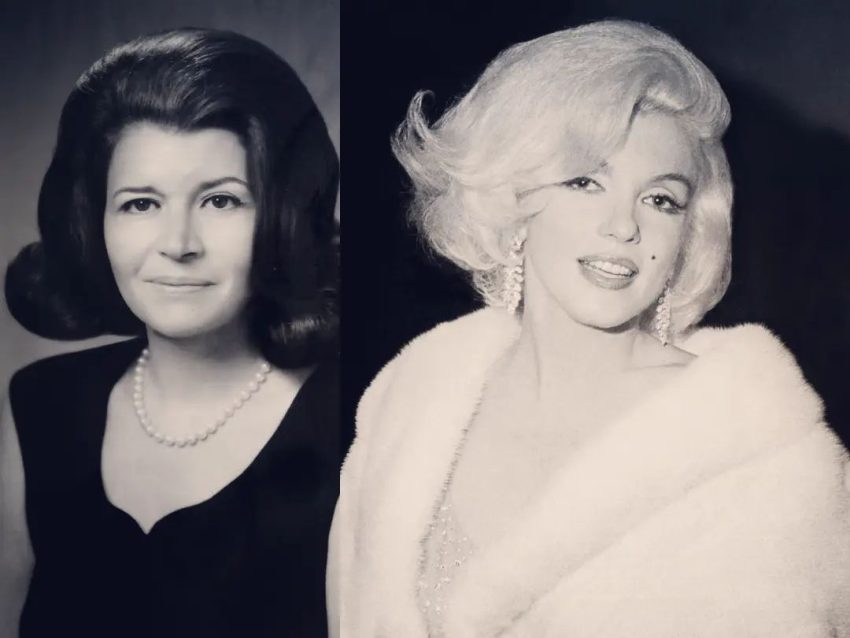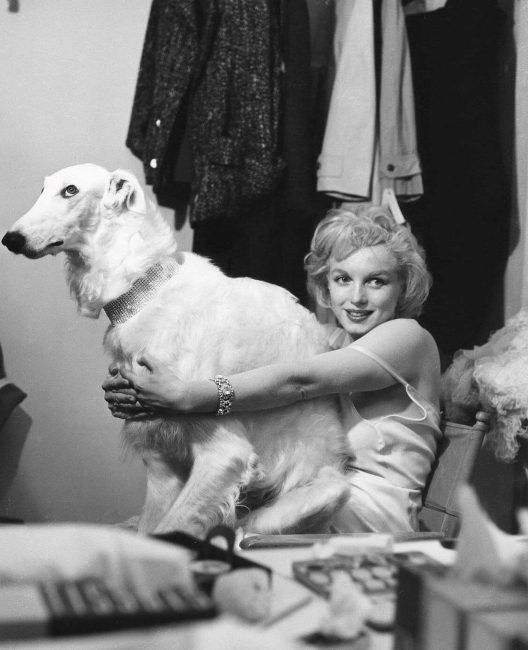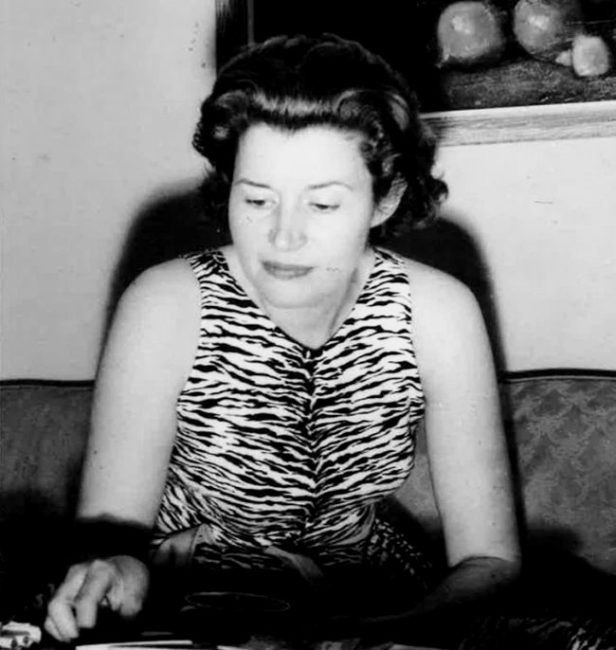Tags
Arthur Miller, Cosmetics, Erin Parsons, Fabled Enchantresses, Happy Birthday Mr. President, Harry Belafonte, John F. Kennedy, Life Magazine, Make-Up, Marie Irvine, Marilyn Monroe, New York, Richard Avedon, Something's Got To Give, The Misfits, Twentieth Century Fox
 Marie Irvine, who worked as a make-up artist to Marilyn Monroe in New York, died aged 99 in a Florida care facility on January 15, 2024.
Marie Irvine, who worked as a make-up artist to Marilyn Monroe in New York, died aged 99 in a Florida care facility on January 15, 2024.
She was born an only child in the small town of Pawling, New York in 1924, and went through grade school in a one-room schoolhouse. She moved to New York City as a teenager and trained as a secretary. Finding the work dull, she took a job at Elizabeth Arden’s flagship salon on Fifth Avenue, and became a beauty advisor and colour specialist.
Marie met a naval officer at Delmonico’s restaurant when he was on leave near the end of World War II. They married in 1947, and later had two children. When her daughter Jane was born in 1957, Marie quit her job with Elizabeth Arden for more flexible hours as a freelance make-up artist.

Her clients included fashion photographers Richard Avedon and Irving Penn, and she also worked on television commercials, even coating actors in layers of green greasepaint to play the Jolly Green Giant, a mascot created to sell canned vegetables. Described as ‘self-effacing and discreet,’ she earned the loyalty of Thelma Foy, daughter of automobile magnate David Chrysler, and one of New York’s best-dressed women.
In 1958, Marie began her working relationship with one of Hollywood’s greatest stars, as she revealed in a 2014 interview (see here) …
I received a call from Richard Avedon. He said that he was shooting a special project for Life magazine with Marilyn Monroe. It was called The Look Alike project [better known as the ‘Fabled Enchantresses’ layout, published in December 1958.]
‘Marilyn would be dressed and made up as different legendary actresses. He told me that Marilyn was between movies. She was living in New York with her husband Arthur Miller and she agreed to do the project whenever she had time.’
Recalling the first time she set eyes on Marilyn, Marie said, ‘How can I forget?! We were waiting at Richard’s studio. I was a bit nervous. She came covered with a big coat, so not to be recognised in the elevator. When she entered, she took off her coat. I was taken by her smile – such perfect white teeth. Her hair was so light, her skin was perfect. She just looked at me and giggled.’
Ultimately that project took three months. Over that time Marie came to know Marilyn who was, she recalled, very much in love with her husband Arthur Miller at that time. Marie said, ‘We could shoot it only when Marilyn felt like it. Sometimes it was in the middle of the night with a short notice. One time it was such a short notice, that I couldn’t find a baby sitter so Marilyn said, “Bring your baby to the set.”
‘I did. Marilyn was playing with her. She posed for photos with her. That is how my daughter has photos with Marilyn Monroe, taken by Richard Avedon. By that time we became friendly. You know, it was only Richard, his helpers, Marilyn and me. So it was like a family atmosphere. She told me how much she wanted a baby. I heard she had lost one. She said she was trying to have a baby.’
At times Marilyn would produce bottles of champagne – sometimes half-drunk and recorked, ‘Can you imagine?’ Marie laughed. ‘We could never figure out how she managed to put the cork back and keep the champagne bubbly.’ It is one of the reasons Marie doesn’t believe Marilyn had a drinking problem. If she did, she asked, ‘Would she have any unfinished bottles at home?’
At the time, Marie recalled, Marilyn and Miller ‘were so in love. Sometimes he would accompany her to the studio and watch her being made up and photographed. Other times he would show up at the end to pick her up and take her home.’
Marilyn’s home, as Marie remembered it, was a very ‘feminine’ space. She said, ‘After the divorce from Miller she stayed at the same home and didn’t change anything. It was all in grey and light beige colours … like her hair. She had a small white piano and there was a coffee table she had borrowed from a friend in France. It was a mirror and the chairs reflected in it. She wanted to buy this table so much but her friend wouldn’t sell it. So one day she told me, “You know what? I will copy the table.” And so she did.’

The first session for Avedon’s ‘Look-Alike Project’ was on May 25, 1958, and some behind-the-scenes photos of Marilyn playing with the dog seen in her ‘Jean Harlow’ shots have since emerged. She would impersonate Lillian Russell, Theda Bara, Clara Bow, and Marlene Dietrich for the shoot, which she later recalled to Simone Signoret as a highlight of her career.
In 2019, the Avedon Foundation shared this rare unpublished image (dated July 2, 1958) on Instagram, showing Marilyn in her dressing room with Marie and her baby daughter.

Marie also worked with Marilyn on make-up tests for The Misfits in New York. Two invoices in Marie’s name, dated September 16, 1960, were found among Marilyn’s personal papers. One reads ‘Special make-up at N.Y. apartment, July 17, 1960;’ the other reads ’12 Leichner eyeshade [sic]’ sent to Reno, Nevada.

In 2009, a $125 invoice sent to Marilyn by Marie (equivalent to $1,200 today) was sold at Julien’s Auctions for $1,152. Dated May 26, 1962, the fee refers to ‘make-up for special appearance at Madison Square Garden‘ on May 19, and was stamped upon receipt on June 5.

‘She always called me herself, without any secretaries. She said she was coming to perform for President Kennedy’s birthday … Of course I read about the upcoming big birthday, and that Marilyn was supposed to be one of the stars attending, but it was exciting to be a small part of all that.’
The day itself didn’t get off to the most auspicious of starts. Marie recalled, ‘I arrived to Marilyn’s home early in the morning as she asked. Nobody opened the door. I kept knocking. After an hour the door opened. Marilyn was standing there so apologetic. She said she arrived on a late flight from LA and fell asleep. She felt so bad for me waiting that she went and squeezed fresh orange juice for me, and then went back to sleep.’
‘I was sort of putting her make-up on for half a day, in between of her being on the phone because she was so upset. She said that (20th Century) Fox was threatening to suspend her from the movie, Something’s Got to Give, if she went to New York to perform at the president’s birthday. She kept saying, “I don’t understand why. I agreed to perform for John (Kennedy) before I signed the contract with Fox. It was in my contract that I needed to be in New York for John’s birthday.’
Marie said, ‘She was fired (by Fox) afterwards.’
Throughout the day, Marie said, ‘She kept practicing on her little piano, with a coach singing, “Happy Birthday. Mr Presidennnt” … She wanted to be perfect. I heard this song so many times that day. And then came the dress … designed by Oscar winning designer Jean Louis. It was layers and layers of material. Each one was see-through but all together, you didn’t see anything. It fitted perfectly to her body.’
Surprisingly, Marie revealed, despite her starring role in the evening, Marilyn bought five tickets – at $1000 a head- to the gala event. It was the only way to guarantee an invite to the private supper afterwards, and an indication of just how insecure the star was in her own charms.
On the night itself she cut a solitary figure – accompanied by only Arthur Miller’s father. Marie said, ‘Well Marilyn was a loner. That is why she was so many hours on the phone. She would call people during the night.’
Moments after Marilyn left to head to the venue Marie noticed that she had forgotten the drop earrings that completed her look that night. She said, ‘Marilyn didn’t like lots of jewellery but this time the earrings were part of the whole look. So I grabbed a cab and rushed to Madison Square Garden. Go only knows how I convinced the security to let me inside but I made it in.
‘Backstage I saw several stars lining up waiting for their turn to perform. Only Marilyn had a dressing room, no-one else! I remember Harry Belafonte standing outside her dressing room. I walked in. Marilyn was alone. She turned, looked at the earrings and smiled. She said, “I knew you would come.”
‘That was the last time I saw her. She died several weeks afterwards.’
And however lonely a figure Marilyn evidently cut in the months across which Marie knew her, the make-up artist cannot believe that she committed suicide. ‘No way,’ she said. ‘I think she might have been confused, disoriented? Maybe she forgot how many pills she took.’
It is clear that the years have done nothing to diminish Marie’s memory or affection for the star she knew all those years ago and for whom being ‘sexy’ came effortlessly, though so much else in her life caused such anxiety.
‘Putting make-up on her was easy because she had this perfect skin. She did use false eyelashes that I used to curl and prepare ahead. But she never talked about a sexy look.
‘She was just “it” – naturally sexy.’

Marie continued working with some of the most iconic models of the 1960s, like Veruschka and Penelope Tree. When Marie and her family moved to New Jersey a few years later, her career in fashion came to an end – her husband, a general counsel for a security firm, didn’t want her to commute. He passed away in 1994.
Marie rarely spoke about her past, but the sale of her invoices put her name on the radar of ardent Monroe fans. On January 5, 2024, celebrity make-up artist and beauty blogger Erin Parsons – who once paid over $15,000 for a Marilyn-owned lipstick – posted a video on TikTok in which she mentioned contacting Marie through her granddaughter Charlotte Bentley, herself a make-up artist and director of communications for luxury fashion retailer Moda Operandi.

Sadly, Marie passed away just ten days later. She enjoyed her moment of fame, despite wishing, per the New York Times, that the attention came when she had more energy to pursue it.
“I told her that the important thing was that it had happened at all,” her daughter said. “She was an original and one of a kind labouring in obscurity to create many beautiful images with the pioneering photographers of the 20th century. After all, how many 99-year-olds who attended one-room schoolhouses go on to be TikTok stars?”

You must be logged in to post a comment.